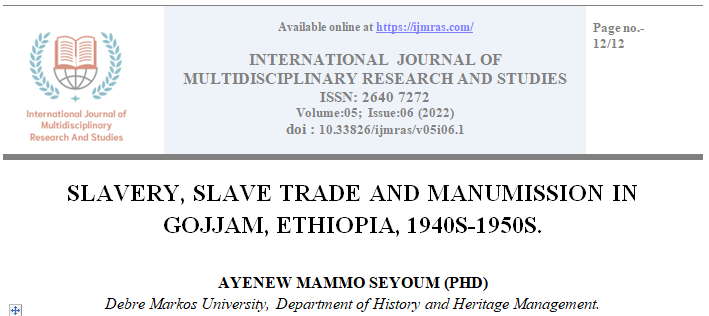SLAVERY, SLAVE TRADE AND MANUMISSION IN GOJJAM, ETHIOPIA, 1940S-1950S.

Abstract
Like in other African countries, in Ethiopia slavery and slave trade were practiced for centuries and had been endemic to the society In this article, I have made an attempt to bring out the efforts of different emperors, particularly Emperor Haile Sellassie’s period in order to regulate and prohibit slavery and slave trade in Ethiopia and to discuss the existence of the institutions and the practice until the 1950s. The attempt of the Ethiopian rulers to regulate or prohibit the slave trade in slaves failed to owe to several reasons. Anyway, the most serious laws making the beginning of the end for the institution of slavery in Ethiopia came in the 1920s. In an attempt to counter European criticism, Rastafari issued an edict in 1923 and 1924 imposing heavy penalties on the slave trade without, however, abolishing the legal status of slavery itself. Later, Ethiopia became a signatory to the ‘Slavery Convention of 1926.’ The official policy of the Ethiopian government against the slave trade, however, did little to stop the regional warlords from continuing to raid the borderlands for slaves. The continuation of slave trading and slavery itself in Ethiopia into the 1930s, the involvement of the state in the trade, and the continued use of slaves in the royal court were directly contrary to the public statements of Emperor Haile Sellassie I and the legal commitments of the Ethiopian state. Immediately after the evacuation of the Italian although Emperor Haile Sellassie made efforts to prohibit the trade in slaves, it continued to flourish. Even in 1942, he issued an edict imposing heavy punishment on those who were involved either in capturing or kidnapping, or selling slaves. Nonetheless, this does not mean that it came to an end. For this, I have discovered archival evidence in the Debre Markos Administrative Office and Higher Court House of Eastern Gojjam Zone, and in Dangla and Metekel administrative offices. Accordingly, the archives I discovered have three categories: the first deals with people who were accused of catching, kidnapping, and selling slaves on the basis of an eye witness who were punished from seven to twenty years of imprisonment. The second category is dealing with people who were accused of kidnapping and selling individuals as slaves for money but for lack of witnesses, who were pardoned and set free. The third phase is connected with the people who after capturing and kidnapping individuals with the intent to sell them to slavery but because of the absence of a purchaser, treated them brutally. The sources are critically collected, scrutinize, and analyzed and their validities are cross-checked one against the other. Finally, as historical research, the paper is based on a systematic selection, collection, and analysis of archival documents, manuscripts, and secondary sources both published and unpublished.
Keywords
Emperors, Slavery and Slave Trade, Decrees, ManumissionHow to Cite
References
Abdussamad H. Ahmad. “Gojjam: Trade, Early Merchant Capital and the World Economy, 1901–1935” (Ph.D. diss. University of Illinois at Urbana-Champaign, 1986).
-------------------------------.
“Trading in Slavesin Bela-Shangul and Gumuz, Ethiopia: Border Enclaves in History, 1897–1938,” Journal of African History 40, no. 3(1999).
Bahru Zewde. A History of Modern Ethiopia, 1855-1991 (Addis Ababa University Press, 2nd ed., 2001).
---------------------.
“Relations between Ethiopia and Sudan on the Western Ethiopian Frontier, 1898-1935” (Ph.D. diss., University of London, 1976).
Donald Donham, “Old Abyssinia and the New Ethiopian Empire: Themes in Social History,” in The Southern Marche sof Imperial Ethiopia: Essays in History and Social Anthropology, ed. Donald Donham and Wendy James
a. Cambridge: Cambridge University Press, 1986).
Emperor Haile Selassie I. My life and Ethiopia’s Progress, 1892-1937: The Autobiography of Emperor Haile
Sellassie I (Edward Ullendorff, trans., Oxford University Press, 1976).
Encyclopedia Aethiopica (Siegbert Uhliged ed., Harrassowitz, 2010).
F.M. Goadby. The Law of Slavery in Abyssinia, in Journal of Comparative Legislation and International Law,
(Hazell, Watson & Viney, Ltd., 1933).
Frederick Cooper. “TheProblemofSlaveryinAfricanStudies,”JournalofAfricanHistory20, no.1 (1979).
HabtamuMengistieTegegne,“LandTenureandAgrarianSocialStructureinEthiopia,1636–1900”(PhDDissertation,
University of Illinois, 2011).
Habtamu Tegegne,“ The Edict of King GälawdéwosagainsttheIllegalSlaveTradeinChristians:Ethiopia,1548,”Medieval Globe2,no.2(2016).
Richard Pankhurst. Economic History of Ethiopia (Haile Selassie I University Press, 1968);
-------------------------.
“Slavery and Emancipation in Traditional Ethiopia: The Role of the Fetha Nagast, or Laws of the Kings,” African and Asian Studies10, no. 1(2011).
-------------------------.
Richard Pankhurst, the Ethiopian Slave Trade in the Nineteenth Century and Early Twentieth Century’s: a Statistical Inquiry, in IX Journal of Semitic Studies No. 1, 220-228 (Manchester University Press, Spring 1964).
-------------------------.
“The Ethiopian Slave Trade in the Nineteenth and Early Twentieth Centuries: A Statistical Inquiry,” in Ethiopian Studies: Papers Read at the 2nd International Conference of Ethiopian Studies (Manchester University, July 1963), ed.
Charles Fraser Beckinghamand EdwardUllendorfff, vol.1, Journal of Semitic Studies 9 (Manchester:ManchesterUniversityPress,1964).
The Fetha Nagast (Paulos Tzadua, trans., Faculty of Law Haile Selassie I University, 1968)
Timothy Fernyhough.“Serfs, Slaves, and Shefta: Modes of Production inSouthernEthiopiafromtheLateNineteenthCenturyto1941”(Ph.D. diss., UniversityofIllinois,1986).
ARCHIVES
• Archives from Debre Markos Regional Administrative Office.
• Archives from Debre Markos University Archive Center.
• Archives from Dangla and Matakal Awrajas.
License
Copyright (c) 2022 Dr. Ayenew , Mammo Seyoum

This work is licensed under a Creative Commons Attribution 4.0 International License.
Individual articles are published Open Access under the Creative Commons Licence: CC-BY 4.0.



